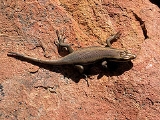
Trachylepis
Encyclopedia

Skink
Skinks are lizards belonging to the family Scincidae. Together with several other lizard families, including Lacertidae , they comprise the superfamily or infraorder Scincomorpha...
genus
Genus
In biology, a genus is a low-level taxonomic rank used in the biological classification of living and fossil organisms, which is an example of definition by genus and differentia...
in the subfamily Lygosominae
Lygosominae
Lygosominae is the largest subfamily of skinks in the family Scincidae. The subfamily can be divided into a number of genus-groups. If the rarely used taxonomic rank of infrafamily is employed, the genus-groups would be designated as such, but such a move would require a formal description...
found mainly in Africa
Africa
Africa is the world's second largest and second most populous continent, after Asia. At about 30.2 million km² including adjacent islands, it covers 6% of the Earth's total surface area and 20.4% of the total land area...
. Its members were formerly included in the "wastebin taxon
Wastebin taxon
Wastebasket taxon is a term used in some taxonomic circles to refer to a taxon that has the sole purpose of classifying organisms that do not fit anywhere else. They are typically defined by their lack of one or more distinct character states or by their not belonging to one or more other taxa...
" Mabuya
Mabuya
Mabuya is a genus of long-tailed skinks nowadays restricted to species from the Americas. The American mabuyas are primarily carnivorous, though many are omnivorous. Formerly, many Old World species were placed here, as Mabuya was a kind of "wastebasket taxon"...
, and for some time in Euprepis. As defined today, Trachylepis contains the clade
Clade
A clade is a group consisting of a species and all its descendants. In the terms of biological systematics, a clade is a single "branch" on the "tree of life". The idea that such a "natural group" of organisms should be grouped together and given a taxonomic name is central to biological...
of Afro-Malagasy mabuyas. The genus also contains a species from the Brazilian island of Fernando de Noronha
Fernando de Noronha
Fernando de Noronha is an archipelago of 21 islands and islets in the Atlantic Ocean, offshore from the Brazilian coast. The main island has an area of and had a population of 3,012 in the year 2010...
, T. atlantica, and may occur in mainland South America with Trachylepis tschudii
Trachylepis tschudii
Trachylepis tschudii is an enigmatic skink, purportedly from Peru. First described in 1845 on the basis of a single specimen, it may be the same as the Noronha skink from Fernando de Noronha, off northeastern Brazil...
and Trachylepis maculata
Trachylepis maculata
Trachylepis maculata is a species of skink in the genus Trachylepis recorded from Demerara in Guyana, northern South America. It is placed in the genus Trachylepis, which is otherwise mostly restricted to Africa, and its type locality may be in error. It is an unstriped, olive-brown, grayish...
, both poorly known and enigmatic. The ancestors of T. atlantica are believed to have rafted
Rafting event
Oceanic dispersal is a type of biological dispersal that occurs when organisms transfer from one land mass to another by way of a sea crossing on large clumps of floating vegetation. Such matted clumps of vegetation are often seen floating down major rivers in the tropics and washing out to sea,...
across the Atlantic from Africa during the last 9 million years.
Species
Listed alphabetically.The species Mabouya punctatissima
Mabouya punctatissima
Mabouya punctatissima is a skink described in 1872 on the basis of a single specimen. It was said to be from South Africa, but later researchers doubted that origin and aligned the species with the Noronha skink from Fernando de Noronha, off northeastern Brazil, instead...
also belongs in this genus, but its exact identity remains unclear.

